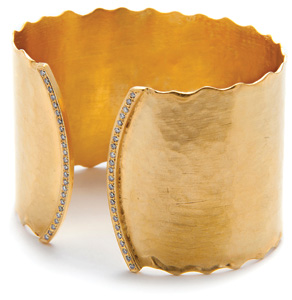
|
Jordan Alexander
|
Step into Marissa Collections in Naples, Florida, and you
immediately sense that a unique shopping experience awaits. The store’s
designer and ready-to-wear collections are complemented by a range of fine
jewelry that is a chic alternative to traditional pieces. Coupled with expert
assistance from the store’s stylists, Marissa Collections has created a winning
formula that has achieved triple-digit growth for jewelry, even during the
recession.
Started in 1975 by Marissa and Burt Hartington as a
storefront boutique, the now 10,000-square-foot store carries about 150 brands
of designer and contemporary clothes and accessories. It has become a
destination for residents of the affluent community, as well as long-time
clients from around the country and abroad, explains Jay Hartington, co-owner.
The highly edited selections are targeted to Baby Boomers, who represent the
majority of their customers. Jay, who admits to having grown up in the back of
the store, oversees marketing, jewelry, website and menswear while Marissa
continues to focus on apparel and Burt manages operations.
While very successful in apparel, the Hartingtons did not
carry jewelry in the store until 2008. In the 2000s, they held trunk shows to
gauge interest. Based upon the positive response, they decided to carry select
lines that would accessorize both the designer and contemporary apparel. The
timing, at the start of the recession, was not favorable. “We had to be as risk
averse as possible,” says Jay, who left a career on Wall Street to join the
family business. “We started small, trying to develop our own niche, always
making a concerted effort not to cannibalize any other designers.”
Their guiding principle, Jay elaborates, which continues to
this day, is to “add great, unique designers who represent the best of that
niche, for example, Yossi Harari
in 24-karat gold jewelry.” He emphasizes the importance of this strategy, given
their clientele. “It’s a departure from buying the traditional — they already
own the big canary diamond ring or cultured pearls. They want what they see in
fashion jewelry — but they want it to be real.”
Today the store carries jewelry at different price points,
from designers that range from Irene Neuwirth and Todd Reed to Jordan Alexander
and Miriam Salat. According to Jennifer McCurry, the jewelry buyer, “We
constantly have a customer in mind when we buy. Like our clothes, our jewelry
selections are very, very well edited.”
Given their successful sales, the Hartingtons decided to
carve out a distinctive space to display the jewelry. “Since we are not a
department store, we wanted to create a fantasy environment and decided to
brand it as a ‘Jewelry Gallery’ because so many of the pieces that we buy are
one of a kind,” says Jay. Many of their customers are art collectors and the
jewelry resembles pieces of art. “The Jewelry Gallery lent itself to that
idea,” he notes.
The Hartingtons commissioned a Swiss company to design
wallpaper that looks like a mural, with holographs illuminating a garden motif.
Custom-made display cases, curved pink couches and green carpet complete the
look. McCurry explains that jewelry is merchandised by genre, not price point.
“If we had a traditional format, the jewelry wouldn’t explode out of the
cases,” says Jay.
Salespeople do not stand behind a case waiting to show the
jewelry. In fact, the staff at Marissa Collections are called stylists, which
more appropriately describes their role.
They are familiar with all the merchandise and try on the jewelry with
different outfits to see how they enhance the clothing and flatter a woman’s
best features. “It is all about preparing before the big game,” Jay emphasizes.
All of the staff is required to take online courses from the
Gemological Institute of America (GIA). Jay is adamant about the need for
“accountability” with the client, who generally knows a lot about jewelry or
can pick up an iPhone to find out.
“If you can’t explain the stone or where the designer got the design
inspiration, you’re making yourself obsolete,” he cautions.
One of the store’s special features is its VIP dressing
room, complete with couch, bar and television, where the stylists lay out the
outfits and display the jewelry next to them. Clients can also bring their own
clothes to the store to be accessorized with jewelry. The stylists will even photograph
the accessorized outfit. Educating the client and making it easy for her to
decide is all part of the “dynamic package” that distinguishes Marissa
Collections, according to Jay.
“We don’t want the client to come in and think that we will
only show her a $50,000 necklace,” Jay says. “Whether the piece is $1,000 or
$100,000, we show the client how to wear it 20 different ways so it is not as
big a price to swallow. The jewelry becomes her second skin.”
“At the end of the day, we are matchmakers between clients
and designers,” concludes Jay. “And the reason that we buy so many
one-of-a-kind pieces is that our clients really want to be different. ‘You have
it and no one else has it.’ That is true luxury.”
Article from the Rapaport Magazine - August 2013. To subscribe click here.